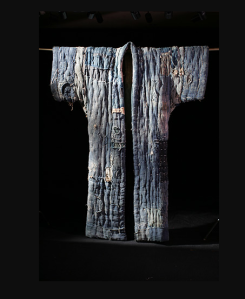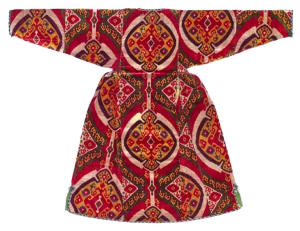
Although here in the UK the museums are still closed, in other parts of the world new exhibitions are opening. Weaving the Thread of Fate into the Carpet – Decorative and Applied Art of Azerbaijan opened last week at the Russian Museum of Ethnography in St Petersburg. This exhibition is a collaboration between the REM and the Azerbaijan National Carpet Museum. It will run until 18 May 2021. On show are more than forty carpets, as well as embroidery, printed textiles, leatherwork and jewellery.

The majority of the carpets date to the late nineteenth and early twentieth century, but the exhibition also features a Surakhani carpet from Baku which dates to the late eighteenth century. A short article about the exhibition has been published in Jozan magazine and can be accessed here. The website of the Azerbaijan National Carpet Museum is well worth visiting. It gives an overview of their collection, and you can also take a virtual tour of the museum.

Turning now to talks taking place in March. The first of these is on Wednesday 10 March when Dr Anita Quye will be interviewed by Dr Mary Dusenbury, guest editor of the recent edition of The Textile Museum Journal, about three dyers who made significant contributions to colour and dyeing technology. “Together with collaborators Iris Brémaud, Dominique Cardon and Jenny Balfour Paul, Dr. Quye conducted comparative research on notebooks compiled by three different dyers between 1722 and 1747 in London and Languedoc, France. In this interview, she will reflect on the similarity of their palettes, the virtuosity of the dyers as colorists, their shared technical language, and the scientific accuracy of the colors in their portfolios.” – Textile Museum website. This event will take place at 12:00 EST, which is 17:00 GMT. The event is free, but you do need to register for it.

On Saturday 13 March Dr Richard Isaacson will give an online presentation to the Textile Museum Associates of Southern California (TMA/SC) entitled Woven Gems along the Silk Road: Small Pile Weavings of the Turkic Nomads of Central Asia. This will take place at 10:00 PST, which is 18:00 GMT. The red carpets and rugs of the Türkmen have long been appreciated in the West. However it wasn’t until much later that textile lovers began to become familiar with the weavings of other related ethnic Turkic groups such as the Uzbeks, Kyrgyz, Kazakhs and Qaraqalpaqs. Dr. Isaacson’s talk will begin with a review of the principal small weavings of the various Türkmen tribes. In the second part of the programme, he will show examples from the other related Turkic tribal groups in Central Asia, and compare them to their Türkmen counterparts. Richard has studied these weavings for many years and in 2007 he curated an exhibition on the Tent Bands of Central Asia for the Textile Museum in Washington. This event is free, but again registration is essential so please do click here if you wish to attend.

The following day, Sunday 14 March, the Textile Arts Council will host a viewing of the award-winning documentary Threads, which shows how the late Surayia Rahman transformed “kantha, the traditional Bengali technique of repurposing old sarees into patchwork embroidered fabrics, into an internationally recognized art form. Today in Bangladesh kantha continues to support women’s economic opportunities and sustains artisan enterprise and the evolution of indigenous design.” – Textile Arts Council. The screening will be followed by a conversation between the documentary-maker, Cathy Stevulak, and Dr. Sanchita Saxena, during which they will discuss the future of this art form, women artisans in Bangladesh and how indigenous arts can be preserved, while at the same time creating a sustainable future for their makers. Non-members are welcome to attend this screening for a small fee. It will take place at 13:00 PST, which is 20:00 GMT and you can register for it here.

If you would like to learn more about the story behind this documentary I suggest you visit the ClothRoads website where they have an interesting blog on how it was made, beginning with the maker hearing about “a woman with grey hair who does remarkable embroidery work”.

The following weekend is a rather busy one, with no less than three talks (that I am aware of) taking place. Firstly the OATG is delighted to be welcoming back Dr. Geneviève Duggan to give another talk – although sadly this one will be online only. Dr. Duggan is an anthropologist who has researched the culture, history and weaving traditions of the remote Indonesian island of Savu for three decades. I have to declare a special interest in this as I too first visited Savu thirty years ago – coincidentally on the same boat as Geneviève, but at a different time. The intriguing title of the talk is People without history in eastern Indonesia, powerful or powerless? Dr. Duggan will discuss several important life cycle ceremonies, which are the responsibility of women “whose intangible power resides in handwoven cloths produced for the occasion”.

The talk will take place on Saturday 20 March at 11:00 am GMT. Unfortunately this timing doesn’t work well for our members on the West coast of the USA, but as Geneviève is based in Singapore we were restricted in our choice. The recording of the programme will later be archived in the members-only section of our website. This event is of course free for OATG members. Non-members are welcome for a small fee, but do need to register by clicking here – don’t forget places are limited! Having visited the weavers on Savu many times, including several times with Geneviève, I can thoroughly recommend this talk.

The next talk on the same day – Saturday 20 March – will be hosted by the Textile Museum as part of its Rug and Textile Appreciation series. The subject will be Embroidered Shoes from the Bata Shoe Museum, 1700-1950. Edward Maeder, who has been a museum curator and director since 1977, ” will explore examples from the world of European high fashion, including remarkable shoes from the 18th and 19th centuries. Maeder will also discuss shoes made with ethnographically specific decorative textile techniques, such as Persian ‘rasht-work’. This type of inlayed wool-work is extensively finished with silk chain-stitch embroidery. Other complex embroidery methods incorporate glass beads, moose-hair and fine gold and silver embroidery on leather, silk and even wool.” – Textile Museum. This free talk will begin at 11:00 EDT, which is 15:00 GMT. Click here to register. Do also take a look at the website of the Bata Shoe Museum as it has lots of interesting posts, particularly on the conservation of different shoes.
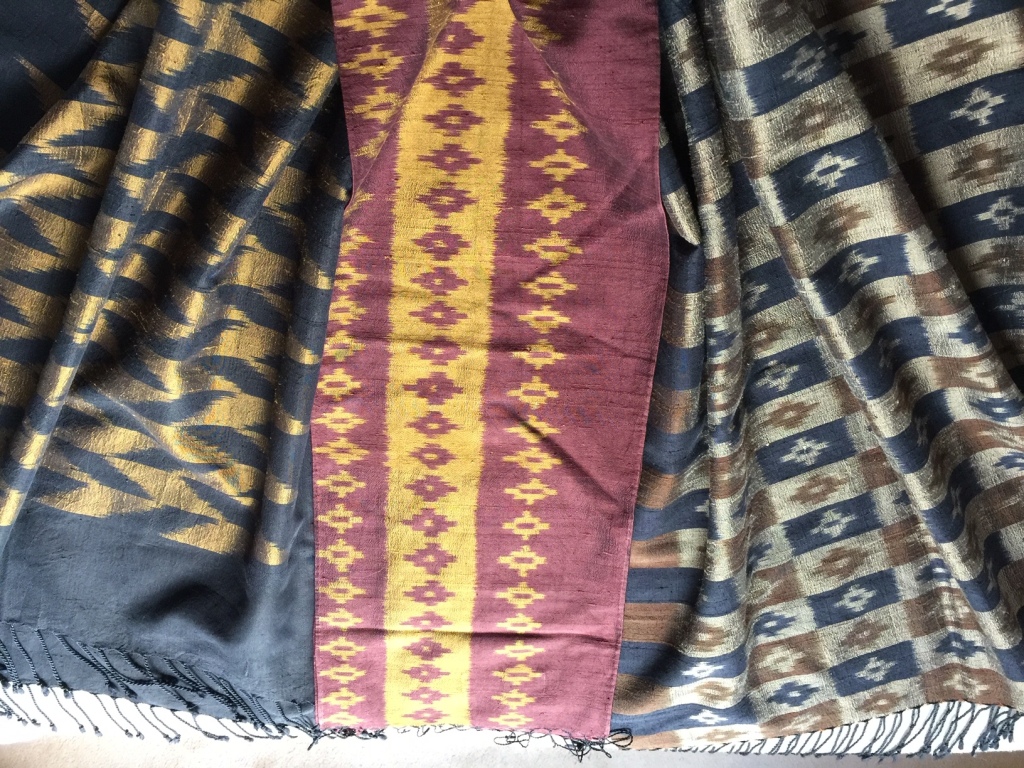
The final talk is again on the same day and hosted by the Textile Arts Council. The speaker is Carol Cassidy and the subject is Weaving, Tradition, Art and Community. Carol founded Lao Textiles in Vientiane in 1990. It was the first American business in the country and was based on the traditional skills of the weavers. Some of the challenges Carol and her husband faced are brought to life in this article in the Wall Street Journal. An experienced weaver herself, Carol made some design alterations to the looms. I’ve been fortunate to visit her twice, in 1997 and again in 2000 and the quality of the textiles is superb. I enjoyed reading this article by someone else who also visited in the 1990s and then much more recently in 2020. She pointed out that “Artisans can only replicate what they have been taught. To bridge the gap between the simplicity of an artisan’s lifestyle and our western sophisticated retail market, Carol and the like are the necessary link to success.” – Valerie Gregori McKenzie. The talk takes place at 10:00 PST which is 17:00 GMT. There is a small fee for non-members and you can register here.

I’ve been working for some time on a list of museums with textile collections and came across a small private museum in Germany dedicated to the molas of Panama. The Forum Mola-Kunst is in the city of Bremen and has a small permanent exhibition of these panels which in the past were only used in women’s blouses, but now are increasingly used on bags etc. Today I discovered that an exhibition of entitled Fashioning Identity: Mola Textiles of Panamá is currently on at the Cleveland Museum of Art. The museum website has an excellent gallery guide, which gives an overview of the history and culture of the people who produce these vibrant textiles.
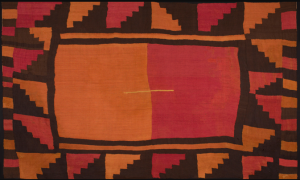
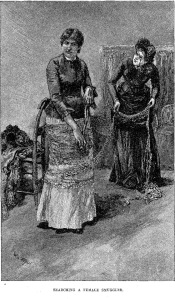 Searching A Female Smuggler. Source: Harper’s, 1884, pg.45.
Searching A Female Smuggler. Source: Harper’s, 1884, pg.45.